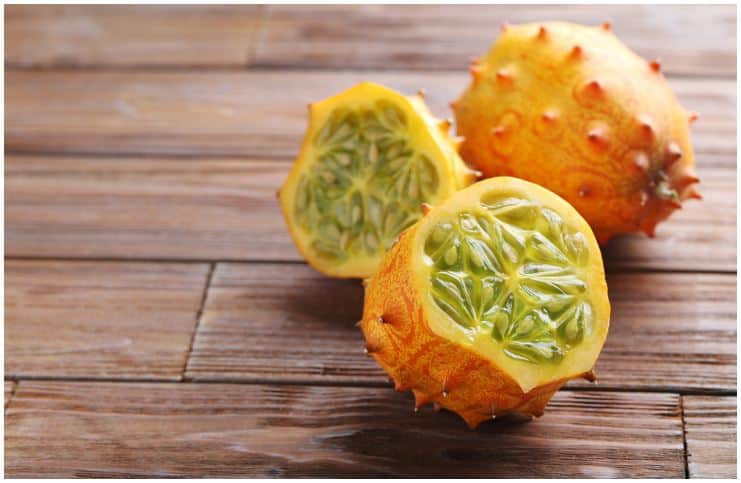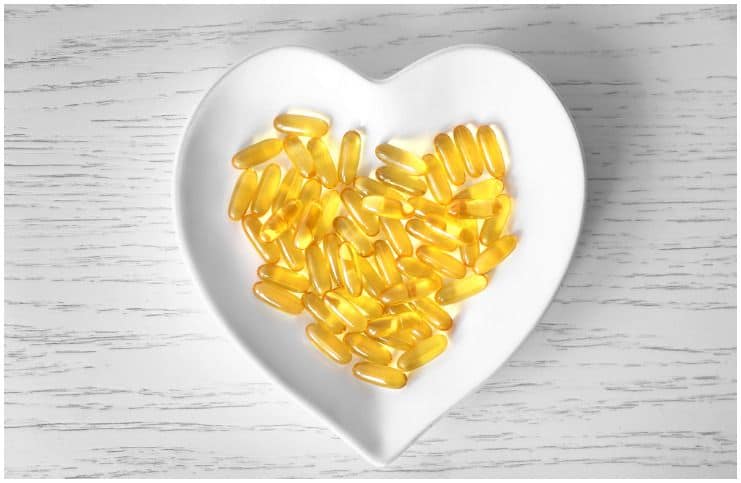Horned Melon (Kiwano): Health Benefits & Side Effects:
Horned melon or kiwano (botanical name Cucumis metuliferus) is a delicious fruit from the Cucurbitaceae family. This family also includes cucumber, melon, pumpkin, butternut squash, bottle gourds, ash gourd, and watermelons.
It is native to the Kalahari Desert in Southern Africa. Presently it is grown in parts of the USA (like California or Mississippi), Portugal, Germany, Italy, Chile, New Zealand, and Australia.
This fruit is also known as African horned melon, gakag, African horned cucumber, jelly melon, melano, spiked pears, hedged gourd, or blowfish fruit.
What does the fruit taste like?
This fruit has a combination of lime green and yellow-orange skin, a texture similar to a cucumber, and jelly-like flesh with a tart taste.
The fruit’s taste has been compared to a mixture of zucchini and cucumber or a combination of cucumber, banana, and lime. However, when it’s very ripe, the banana flavor will start to feel better.
The seeds are covered in a gel-like substance and can be eaten like a pomegranate. These seeds are full of antioxidants like y-tocopherol and a-tocopherol, which are organic types of vitamin E.
Nutritional Profile
The fruit consists of over 89% water and is a source of minerals like – copper, iron, magnesium, manganese, sodium, zinc, selenium, calcium, potassium, and phosphorous; vitamins, such as – A, B1, B3, B5, B6, B9 (folate), C, E, K; fiber; omega 3 and 6 fatty acids; protein.
Some individuals eat the peel, which is very rich in dietary fiber and vitamin C.
Health Benefits of Horned Melon
Bone Health
Vitamin K is capable of opposing many of the leading chronic diseases in modern-day Americans, including atherosclerosis and diabetes, because it has the unique capacity to activate proteins involved in the prevention of these diseases.
Scientists have also demonstrated that vitamin K is also involved in building bones.
A 1999 study at the Department of Medicine, Harvard, Boston, USA, concluded that women who get at least 110 micrograms of this important vitamin daily are 30 percent less likely to break a hip than women who get less than that (1).
100g of this fruit contains 14% percent vitamin K of the recommended daily intake.
Prevents Anemia
Iron deficiency is the most frequent nutritional deficiency in the United States, according to the Centers for Disease Control, with almost 10% of women being considered iron deficient.
Iron is needed to produce hemoglobin, a protein found in red blood cells that transport oxygen from your lungs throughout your body to your cells.
In addition, iron in the diet is particularly beneficial for the health of T-cells (a type of lymphocyte essential for human immunity) and the capacity of white cells to consume bacteria.
100g of this fruit contains 14% percent iron of the recommended daily intake.
Boosts Physical Exercise Performance
Magnesium plays many important roles in the health of your brain and body. Numerous studies have shown that consuming magnesium-rich foods can boost exercise performance for athletes.
According to a 2014 study, this mineral helps dispose of lactic acid and move blood sugar into your muscles, which can build up in muscles during physical exercise and cause pain (2).
100g of this fruit contains 10% percent magnesium of the recommended daily intake.
Reduces Stress
Vitamin C is important for the growth and repair of tissues in our body, and because the body does not store vitamin C in its tissues, we need a daily intake.
Moreover, vitamin C helps the body deal with stress by reducing the elevated levels of stress hormones (3).
100g of this fruit contains 6% percent vitamin C of the recommended daily intake.
Improves Your Vision
Beta-carotene is a molecule that the body easily changes into vitamin A that has potent antioxidant functions which help the body scavenge free radicals, thereby limiting damage to DNA, cell membranes, and protein structures in the tissues.
Furthermore, beta-carotene is converted into retinal (a polyene chromophore) that is crucial for vision and eventually into retinoic acid for cellular growth, including in the eye (4).
100g of this fruit contains 5% percent vitamin A of the recommended daily intake.
Skin Health
Zinc is responsible for many different functions in the human body and also helps stimulate the activity of 100 types of enzymes.
In addition, zinc is required for the production of collagen, the main component of the connective tissue, which is required for skin regrowth and repair.
Furthermore, this mineral prevents cellular damage in the retina, which helps in delaying the progression of vision loss and AMD, according to a 2001 study (5).
100g of this fruit contains 4% percent zinc of the recommended daily intake.
Autoimmune Diseases Prevention
In 2016 a study at the Australian National University established that intaking enough omega-3s during the first year of life is strongly associated with a reduced risk of many autoimmune diseases, including type 1 diabetes (6).
Furthermore, omega-3 supplements do not reduce the risk of heart attacks or strokes; thus, it is better to eat whole foods.
100g of this fruit contains 19% percent omega 3 of the recommended daily intake.
Side Effects Of Kiwano
There are no known side effects of consuming this fruit. However, consuming the fruit before it is ripe can cause stomach issues.
Selection and Storing
Before you buy it, make sure you choose a fruit without any spots or bruises, that is not too hard and has an orange color (the brighter the orange skin, the sweeter the flesh of the fruit). Moreover, it is ideal to purchase a fruit that has the horns undamaged, as damaged horns may be an indication of hard handling.
Unripe C. metuliferus can be stored at room temperature for about 10 to 14 days, although it will be kept for a few weeks under refrigeration. A ripe fruit will last about 3 to 4 days at normal room temperature.
How to eat
This fruit can be eaten when it is completely ripe. A usual method to eat the fruit is to cut it in half and then take pieces with a spoon.





